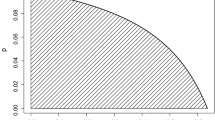Abstract
This paper is concerned with predicting the probability of tendering the lowest bid in sealed bid auctions. Four of the leading models from the bidding literature are shown to be subsumed within a generalised model. These models are then tested relative to the equal probability model by an empirical analysis of a large sample of real construction contract bidding data via all-in, one-out and one-on sample frames. A binomial test is used to measure the ability to predict the identity of the lowest bidders and the average logscore is used to measure the ability to predict the probability of each bidder being the lowest. Optimal cut-off criterion values are determined for defining the minimum size of dataset needed for disaggregating bidders. The work also highlights the importance of (1) the treatment of new entrants and general shortage of data on individual bidders, and (2) the treatment of predicted ties.
Similar content being viewed by others
Author information
Authors and Affiliations
Corresponding author
Rights and permissions
About this article
Cite this article
Skitmore, M. Predicting the probability of winning sealed bid auctions: a comparison of models. J Oper Res Soc 53, 47–56 (2002). https://doi.org/10.1057/palgrave.jors.2601236
Received:
Accepted:
Published:
Issue Date:
DOI: https://doi.org/10.1057/palgrave.jors.2601236




